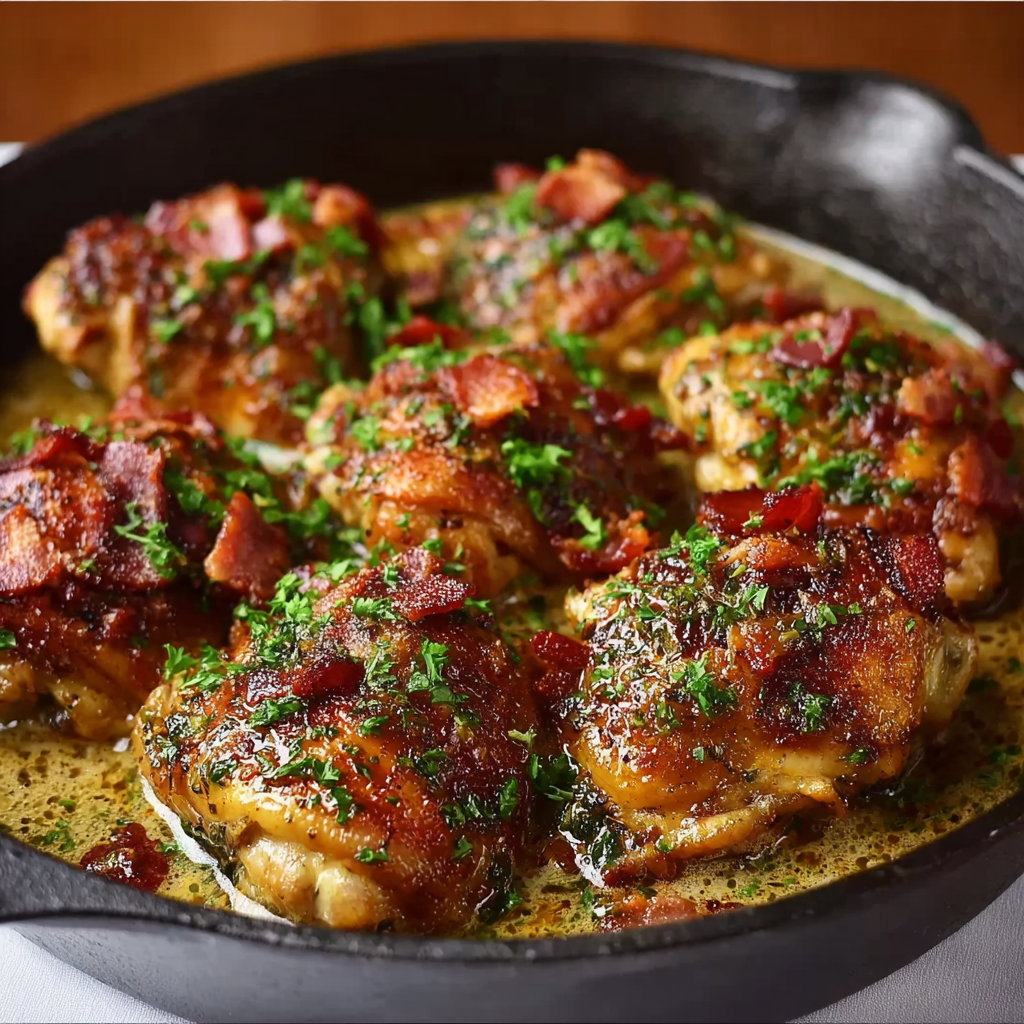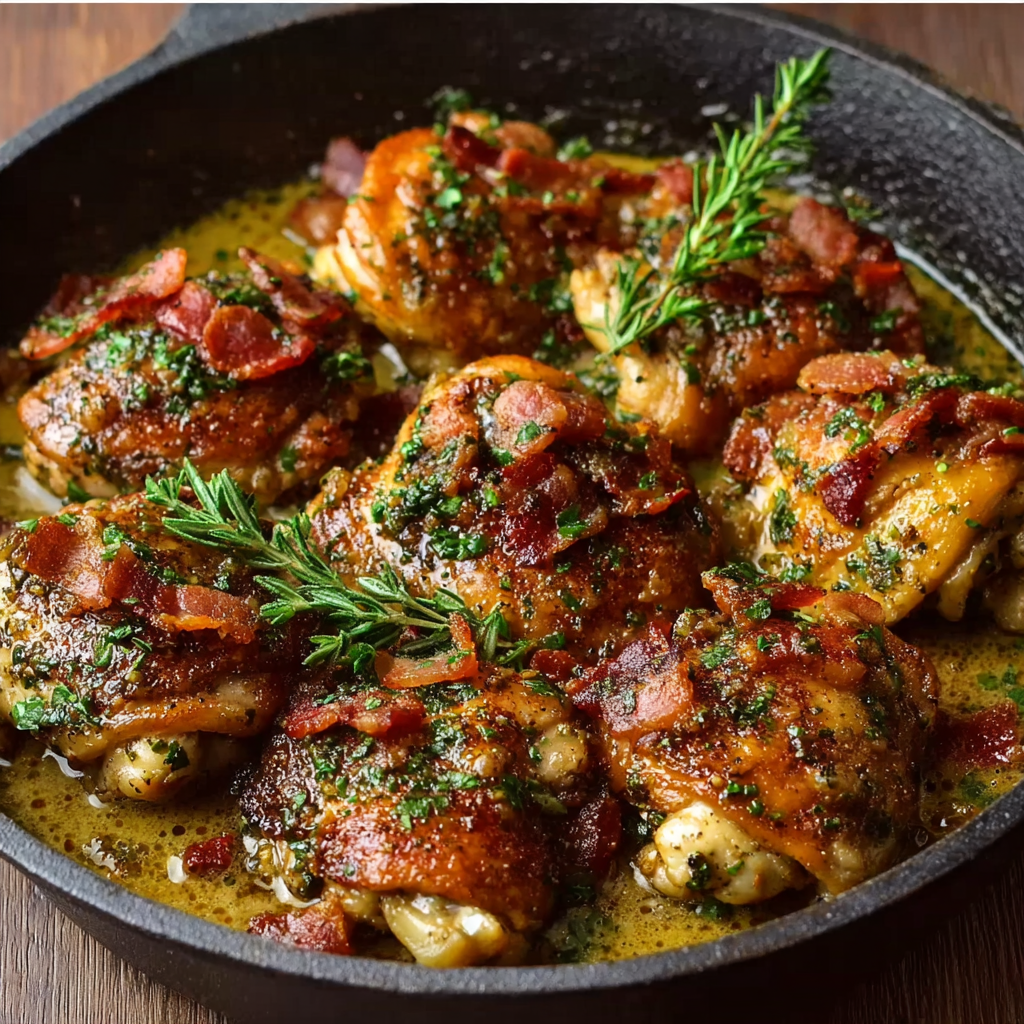Loaded Chicken Bacon Skillet Dinners: Bold Flavor, One Pan, Zero Fuss
When you’re craving a comforting meal that delivers big on flavor but doesn’t leave behind a sink full of dishes, Loaded Chicken Bacon Skillet Dinners are your answer. This crowd-pleasing recipe combines juicy chicken, crispy turkey bacon, and a rich, creamy Parmesan sauce—all made in a single skillet. It’s fast, satisfying, and fits right into busy weeknights or low-effort weekend meals.
Why One-Pan Meals Work So Well
The rise of one-skillet dinners isn’t just a social media trend—it’s a return to efficient, flavorful cooking. From Mediterranean shakshuka to Asian stir-fries and Italian risottos, the concept of cooking everything in one pan has been used around the world for centuries. As Wikipedia’s One-Pot Meals entry notes, this method streamlines meal prep and enhances flavor by letting ingredients cook and meld together naturally.
What Makes This Skillet Dish Stand Out?
-
Flavor-packed base: Turkey bacon is crisped in the skillet, releasing savory drippings that serve as the base for sautéed garlic, onions, and smoked paprika.
-
Protein-rich: Chicken breast or thighs soak up the seasoning, keeping the dish satisfying and lean.
-
Creamy, indulgent finish: Heavy cream and Parmesan cheese melt into a luxurious sauce that coats every bite without feeling heavy.
It’s comfort food done the smart way—balanced and layered, yet simple to pull off.
Nutritional & Dietary Highlights
This dish isn’t just tasty—it’s versatile and adaptable to many dietary lifestyles:
-
Low-carb & keto-friendly: With no pasta or grains, this skillet fits seamlessly into low-carb or keto diets.
-
High-protein: Chicken and turkey bacon provide a satisfying protein boost.
-
Easy to modify: Swap in plant-based cream, use pork bacon, or toss in spinach or mushrooms for a veggie twist.

Why One-Pan Dinners Are So Popular
The growing popularity of one-pan dinners mirrors today’s home cooking trends: convenience, minimal cleanup, and maximum flavor. In a fast-paced world where time is limited but expectations for delicious, home-cooked meals remain high, dishes like the loaded chicken bacon skillet check all the right boxes.
Convenience That Works for Real Life
One-skillet meals streamline the cooking process by:
-
Reducing prep time and dishwashing
-
Consolidating ingredients into a single cooking vessel
-
Making it easy to batch cook or meal prep
For busy families, working professionals, and weeknight warriors, this translates into less stress and more time to enjoy the meal.
Layered Flavor in One Pan
It’s not just about ease—it’s about deep, developed flavor. Cooking everything in one pan means the ingredients build on one another:
-
Chicken browns and releases savory juices.
-
Turkey or pork bacon adds smoky richness.
-
Aromatics like garlic and paprika deepen the base.
-
Fond (browned bits) at the bottom of the pan infuses the sauce with umami and complexity.
This technique, commonly used in professional kitchens and outlined in sources like Wikipedia’s chicken as food, turns simple steps into restaurant-level results.
Trending & Trusted
On platforms like Pinterest, terms like “easy one-skillet meals,” “15-minute skillet dinners,” and “healthy chicken skillet recipes” are constantly trending. That’s because one-pan meals offer:
-
Adaptability – swap ingredients based on what’s in your fridge
-
Reliability – tested techniques that work every time
-
Visual appeal – Instagram-worthy meals with minimal effort
Recipes like the loaded chicken bacon skillet are not only delicious but also meal-plan friendly, keeping your week streamlined without sacrificing variety.
Skillet Cooking = Smart Cooking
The beauty of one-pan dinners is how efficient and flavorful they are. Whether it’s a creamy Tuscan chicken skillet or a low-carb bacon chicken bake, these meals deliver comfort and complexity—all from one trusty pan.
In short, one-skillet recipes aren’t just trending—they’ve become a cornerstone of modern cooking, proving that with the right technique and ingredients, quick dinners can be truly unforgettable.
Healthier Twist with Turkey Bacon
Using turkey bacon in a skillet meal is more than just a swap—it’s a strategy for cutting down on saturated fat while maintaining bold, smoky flavor. In this loaded chicken bacon skillet dinner, turkey bacon delivers crunch and depth without the heaviness of traditional pork bacon.
One of the key reasons home cooks are leaning toward turkey bacon is its lower fat content. It typically contains fewer calories and significantly less saturated fat, making it a better choice for those following heart-healthy or low-carb diets. According to Wikipedia’s article on turkey bacon, it’s made from chopped, seasoned, and reformed turkey, offering a leaner protein source that still brings the umami and smoke you expect in a bacon dish.
In recipes like this one, turkey bacon shines when crisped up in a skillet first. It renders enough fat to build a flavorful base for garlic, butter, and spices, while keeping the dish balanced and lighter than versions made with pork. The residual drippings are just enough to sauté the chicken to golden perfection.
This substitution doesn’t mean sacrificing taste. Many cooks find that turkey bacon blends better with other ingredients like chicken broth, Parmesan, and cream without overpowering them. And if you’re experimenting with healthier recipes, check out our clean eating chicken meal plan or this list of healthy skillet dinner ideas for more inspiration.
Choosing turkey bacon is a small adjustment that makes a big impact—on your health goals and on the final flavor of your skillet dinner.
Core Ingredients Breakdown & Benefits
The magic of a loaded chicken bacon skillet dinner lies in its carefully chosen ingredients. Each component plays a unique role—bringing flavor, texture, and nutritional value to the skillet. Here’s a closer look at the elements that make this dish a weeknight favorite.
Chicken (Thighs or Breasts)
Both chicken thighs and chicken breasts work beautifully in this recipe. Thighs are slightly higher in fat, resulting in a richer, juicier bite, while breasts offer a leaner, high-protein option. According to Wikipedia’s overview of chicken as food, chicken is an excellent source of lean protein, making it a staple in balanced meals.
Turkey Bacon
A lighter alternative to pork, turkey bacon gives you the smoky bite you crave without the extra grease. It crisps up well and adds complexity to the dish’s flavor profile. Its leanness also means the final skillet meal won’t feel overly heavy. Learn more about how turkey bacon is made in this Wikipedia article.
Olive Oil & Butter
These fats provide the base for sautéing and sauce-building. Olive oil brings healthy monounsaturated fats, while butter adds a rich mouthfeel and golden color when combined with garlic and spices.
Garlic
Minced garlic is one of the most important flavor builders in the skillet. It infuses the oil and butter with a savory aroma and layers the dish with complexity. According to Wikipedia’s garlic in cooking, garlic also contains allicin, a compound linked to health benefits like improved heart health.
Smoked Paprika & Onion Powder
These pantry staples add subtle heat and depth. Smoked paprika brings a sweet, smoky element, while onion powder offers savory umami. Read more about this spice’s origins and varieties in the paprika Wikipedia entry.
Chicken Broth
Used to deglaze the skillet, chicken broth helps pull up all the flavorful browned bits left from cooking the meat. This forms the flavorful base of the cream sauce.
Heavy Cream
Rich and luscious, heavy cream transforms the dish into a silky, indulgent meal. It balances the saltiness of the bacon and enhances the Parmesan’s nuttiness. You can learn more about its role in sauces in this article on cream sauces.
Parmesan Cheese
Parmesan adds sharp, salty depth and helps thicken the sauce. It melts into the broth and cream, giving the dish a signature creamy texture. For a detailed look at its origins, visit the Parmigiano Reggiano Wikipedia page.
Fresh Parsley & Lemon (Optional)
These finishing touches brighten the dish and cut through the richness. A sprinkle of chopped parsley and a squeeze of lemon juice elevate both flavor and presentation.
Looking for other recipes with similar ingredients? Try our one-pan garlic butter chicken or check out these delicious chicken and bacon recipe ideas on Pinterest for more inspiration.
These ingredients aren’t just pantry staples—they’re the foundation of a meal that’s simple to make and rich in flavor, texture, and nutrition.
How to Perfectly Cook Chicken in a Skillet
Mastering the technique of cooking chicken in a skillet is essential for delivering juicy, golden pieces every time. In a loaded chicken bacon skillet dinner, poorly cooked chicken can break the dish. Use the following tips to get it right from the start.
Choose the Right Cut
You can use either boneless chicken thighs or breasts for this recipe. Thighs offer a more forgiving cook time thanks to their higher fat content, while breasts are leaner but easier to overcook. Both should be cut into uniform chunks to ensure even cooking. For more context on cut types, refer to chicken as food.
Prep for Success
Before searing, pat the chicken dry with paper towels. Moisture on the surface causes steaming instead of browning. Season generously with salt and pepper, coating each piece evenly. If you’re prepping ahead, marinating in olive oil, garlic, and smoked paprika enhances flavor absorption.
Use the Right Pan and Temperature
A heavy-bottomed, nonstick or stainless-steel skillet works best. Heat it over medium-high and add olive oil until it shimmers—this ensures your chicken will sear properly. Overcrowding the pan is a common mistake. Cook in batches if needed to avoid steaming.
As chicken cooks, it leaves behind golden-brown bits—called fond—on the skillet’s surface. These bits are crucial for flavor development in one-pan meals. According to Wikipedia’s one-pot meal entry, these layers of flavor are characteristic of this cooking method and enrich the sauce that follows.
Flip and Finish
Let the chicken cook undisturbed on one side for 4–5 minutes until it forms a golden crust. Flip and cook an additional 3–4 minutes until the internal temperature hits 165°F (74°C). Use a digital thermometer for accuracy. Once done, transfer the chicken to a plate to rest.
Need help choosing a pan? Check out our guide to the best nonstick skillets. Or, for another high-protein skillet option, try this creamy Tuscan chicken skillet that follows similar cooking techniques.
Getting this step right sets the foundation for everything that follows—especially the creamy, bacon-rich sauce that ties the dish together.
Step-by-Step Cooking Instructions
Creating a loaded chicken bacon skillet dinner doesn’t require fancy tools or advanced skills—just a few ingredients, one pan, and the right method. Follow these steps carefully to build flavor at every stage and ensure a creamy, satisfying result.
1. Crisp the Turkey Bacon
-
Heat a large skillet over medium heat.
-
Add the chopped turkey bacon and cook until crispy, about 5–7 minutes.
-
Remove the bacon with a slotted spoon and set aside, leaving about 1 tablespoon of rendered fat in the pan.
Cooking the bacon first allows its smoky flavor to infuse the rest of the ingredients. For a lighter take, read more about turkey bacon’s health benefits and how it compares to pork-based versions.
2. Sear the Chicken
-
Season the chicken thighs or breasts with salt and pepper.
-
Add 1 tablespoon olive oil to the pan.
-
Sear the chicken in a single layer for 4–5 minutes per side, until golden and fully cooked.
-
Transfer to a plate and set aside.
At this point, fond will develop—those browned bits on the bottom of the skillet—which you’ll incorporate into the sauce later. This method, explained in Wikipedia’s one-pot meal entry, helps build layers of flavor.
3. Build the Flavor Base
-
Reduce heat to medium and add 3 tablespoons of butter to the same pan.
-
Stir in 4 cloves of minced garlic and cook until fragrant, about 30 seconds.
-
Add 1 teaspoon smoked paprika and 1 teaspoon onion powder, stirring to combine.
Using both spices creates a deep, smoky backdrop for the sauce. Want more ideas for spice layering? Browse our spice-blend guide for chicken skillets.
4. Deglaze and Simmer
-
Pour in ½ cup chicken broth to deglaze the pan, scraping up the fond.
-
Simmer for 2–3 minutes, allowing the liquid to reduce slightly.
This stage enhances both the aroma and body of the final sauce. Deglazing is a hallmark of great skillet cooking and a staple of flavor-forward dishes like chicken and bacon recipes.
5. Create the Cream Sauce
-
Lower heat and stir in ½ cup heavy cream and ½ cup grated Parmesan cheese.
-
Cook for 2–3 minutes, stirring until the sauce thickens.
For more on the role of dairy in sauces, explore this overview of cream sauces. The Parmesan also contributes to umami and acts as a natural thickener. For quality tips, see Parmesan cheese.
6. Combine and Finish
-
Return the chicken and bacon to the skillet, tossing to coat in the sauce.
-
Simmer for another 2–3 minutes until heated through.
7. Garnish and Serve
-
Top with chopped fresh parsley and a squeeze of lemon juice if desired.
-
Serve hot, directly from the skillet.
Looking for more dinner ideas with this method? Try our easy one-skillet meals roundup or this reader-favorite low-carb chicken skillet.
This simple, structured method ensures your skillet dinner comes together quickly—without sacrificing depth, richness, or texture.

Serving Suggestions & Pairings
The beauty of a loaded chicken bacon skillet dinner lies not only in its flavor but in its flexibility. This one-pan dish is hearty on its own, but it also pairs beautifully with a variety of sides—whether you’re going for a low-carb approach or craving a cozy, carb-friendly complement.
Low-Carb Options
-
Cauliflower rice – A grain-free favorite that soaks up the rich, creamy sauce.
-
Zucchini noodles (zoodles) – Light, fresh, and a perfect base for skillet sauces.
-
Steamed greens – Spinach, kale, or Swiss chard add color and nutrition without heaviness.
Explore more creative low-carb dinner pairings in our healthy skillet recipe guide.
Hearty Comfort Sides
-
Garlic mashed potatoes – Ideal for soaking up every drop of creamy Parmesan sauce.
-
Buttered pasta or noodles – A classic choice for turning this into a full comfort meal.
-
Crusty bread – Perfect for dipping and sopping up sauce from the skillet.
Veggie Side Dishes
-
Roasted Brussels sprouts – Their caramelized edges pair well with smoky bacon.
-
Grilled asparagus – Adds crunch and a bright, green contrast.
-
Simple salad – Lighten the richness with an arugula salad and lemon vinaigrette.
Want to explore more chicken and bacon dinner ideas with flexible side pairings? Check out this collection of pinned recipes for inspiration.
Easy Variations & Add-ins
This dish is incredibly adaptable, making it perfect for customizing based on your preferences or pantry. Here are ways to add variety without losing the essence of a great chicken bacon skillet.
Add More Veggies
-
Baby spinach – Toss in a few handfuls during the final simmer for a boost of nutrients.
-
Mushrooms – Sauté with the garlic and butter to add earthiness.
-
Cherry tomatoes – Add them with the chicken broth for a sweet, acidic balance.
Change Up the Flavor
-
Make it spicy – Add crushed red pepper flakes or cayenne for heat.
-
Swap the cheese – Try Asiago, mozzarella, or Gruyère in place of Parmesan.
For tips on cheese pairings in creamy dishes, refer to Parmesan cheese.
Go Dairy-Free
-
Use coconut cream in place of heavy cream.
-
Swap Parmesan for nutritional yeast for a savory, cheesy flavor.
Add Whole Grains or Pasta
-
Stir in cooked quinoa, farro, or brown rice for a more filling one-bowl meal.
-
Add cooked pasta like penne or rotini for a creamy chicken bacon pasta skillet.
Looking for more recipes with flexible add-ins? Our one-skillet recipe collection is full of customizable meals for every diet.
Storage, Reheating & Meal Prep Tips
This recipe doesn’t just make a great dinner—it also stores and reheats well, making it a strong choice for meal prep or leftovers.
Storing Leftovers
-
Store in an airtight container in the refrigerator for up to 4 days.
-
To freeze, portion the dish into meal-size servings and store for up to 2 months.
Reheating Instructions
-
Reheat on the stovetop over low heat, adding a splash of chicken broth or cream to loosen the sauce.
-
Microwave in 30-second intervals, stirring between each to prevent curdling.
Meal Prep Ideas
-
Pre-chop your chicken and bacon and store in separate containers.
-
Prepare spice mixes in advance to save time during cooking.
-
Double the recipe and freeze half for a ready-to-go dinner on busy nights.
Want more one-pan recipes ideal for prepping ahead? Try our easy skillet meal prep ideas or browse our Pinterest board for prep-friendly inspiration.
FAQs – Based on “People Also Ask”
Q1: Can I use pork bacon instead of turkey bacon?
Yes. Pork bacon delivers a deeper, smokier flavor but also contains more fat and calories. Make sure to drain the excess grease before combining it with other ingredients. For a lighter, leaner option, turkey bacon crisps up well and complements creamy sauces without overwhelming them.
→ Learn more about bacon swaps
Q2: Is this recipe keto or low-carb friendly?
Absolutely. This dish is naturally low in carbs and rich in healthy fats and protein, making it a great fit for keto diets. Just avoid high-carb sides like bread, rice, or potatoes when serving.
→ For more ideas, check out our Low-Carb Chicken Dinner Roundup
Q3: What can I substitute for heavy cream?
You can swap in half-and-half for a lighter option or use unsweetened coconut cream to keep it dairy-free. Keep in mind that consistency and richness may vary slightly depending on your substitution.
→ Read more on cream sauce substitutions
Q4: Can I make this in the oven instead of the stovetop?
Yes. Once all ingredients are combined, you can bake the dish at 375°F (190°C) for 10–15 minutes. This method works particularly well if you’re adding extra cheese on top for a bubbly, golden finish.
Q5: How do I prevent the sauce from curdling?
To avoid curdling, keep the heat low when adding cream and cheese. Stir constantly and never let the sauce boil after dairy is added. Slowly incorporate cream and Parmesan for a smooth, cohesive sauce.
How to Make the Perfect Bacon Butter Chicken Skillet in One Pan
Turn any weeknight into a restaurant-worthy experience with this creamy, loaded chicken bacon skillet. Juicy chunks of chicken and crispy turkey bacon are simmered in a buttery garlic-Parmesan sauce that’s both rich and comforting. Made entirely in one skillet, this dish is quick to prepare, full of flavor, and perfect for anyone craving a low-effort, high-impact dinner. Whether you’re serving it over mashed potatoes or keeping it low-carb with cauliflower rice, it’s guaranteed to become a family favorite.
- Author: Clara
Ingredients
- 4 slices turkey bacon, chopped
- 1 ½ lbs boneless, skinless chicken thighs or breasts, cut into chunks
- Salt and pepper to taste
- 1 tbsp olive oil
- 3 tbsp butter
- 4 cloves garlic, minced
- 1 tsp smoked paprika
- 1 tsp onion powder
- ½ cup chicken broth
- ½ cup heavy cream
- ½ cup grated Parmesan cheese
- 1 tbsp chopped fresh parsley (optional)
Instructions
Heat a large skillet over medium heat. Cook the chopped turkey bacon until crispy. Remove from the skillet and set aside, leaving about 1 tablespoon of the drippings.
Season the chicken pieces with salt and pepper.
Add olive oil to the same skillet and cook the chicken until golden brown and cooked through. Remove and set aside.
In the same skillet, melt butter and sauté garlic until fragrant. Add smoked paprika and onion powder.
Pour in the chicken broth and stir, scraping any browned bits from the bottom of the skillet. Simmer for a couple of minutes.
Lower the heat and stir in the heavy cream and Parmesan cheese. Cook until the sauce is thickened.
Return the chicken and turkey bacon to the skillet, stirring to coat with the sauce. Simmer for another 2–3 minutes.
Garnish with chopped parsley before serving, if desired.
Notes
-
Cooking Order Matters: Always cook the bacon first to render flavorful fat that becomes the base of the sauce.
-
Don’t Skip the Deglazing Step: Use chicken broth to scrape up all the browned bits—it intensifies the flavor and forms the foundation of the creamy sauce.
-
Parmesan Tip: Use freshly grated Parmesan for the smoothest melt and best flavor—pre-shredded varieties may not blend well.
-
Customize It: Add spinach, mushrooms, sun-dried tomatoes, or swap in a different cheese for variety.
-
Make It Spicier: Add crushed red pepper flakes or cayenne when sautéing the garlic for a bit of heat.
-
Storage: Keeps well in the fridge for up to 4 days. Freeze in airtight containers for longer storage.
-
Best Skillet Type: A well-seasoned cast iron or heavy stainless steel skillet works best for even heat distribution and flavor development.





